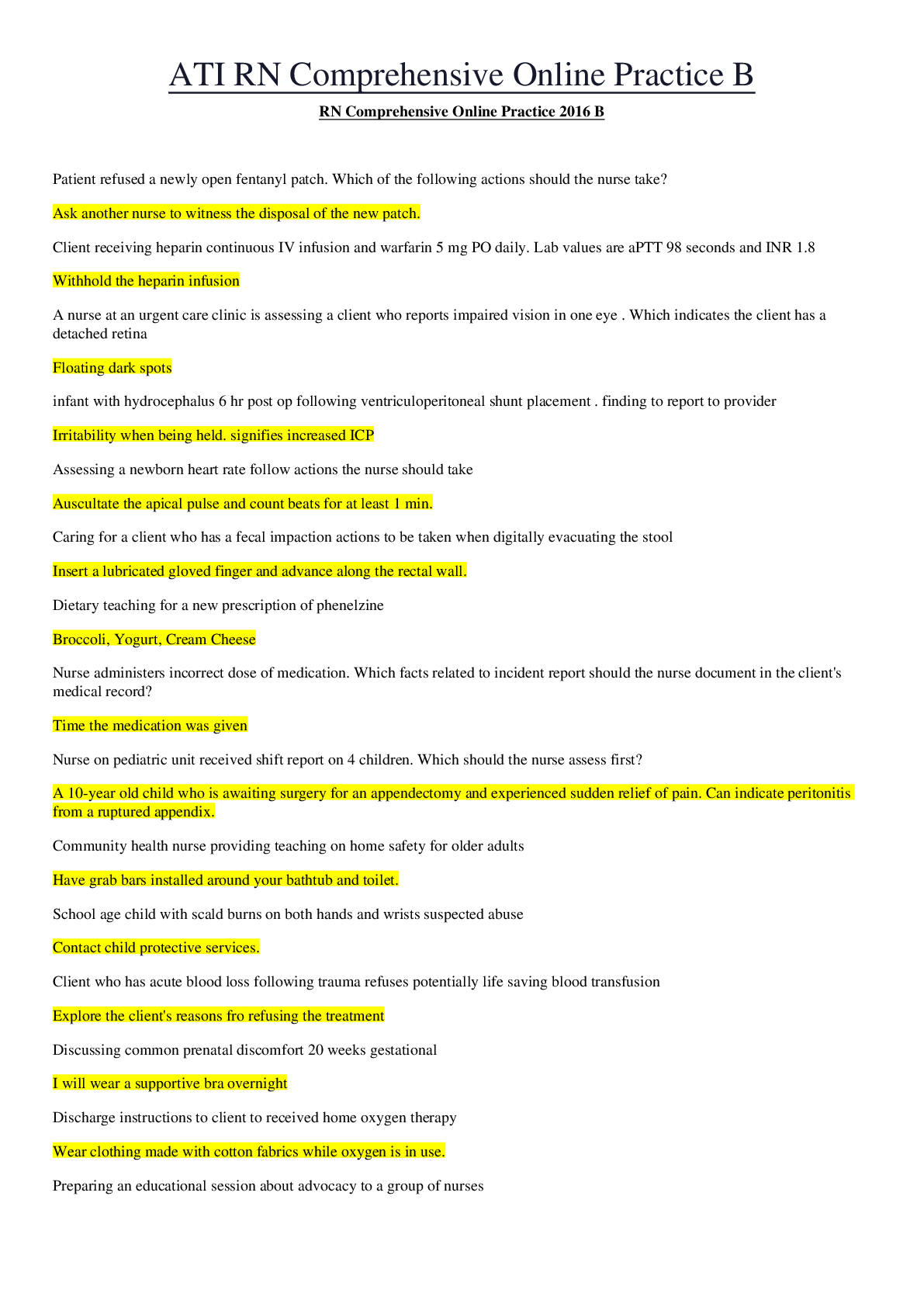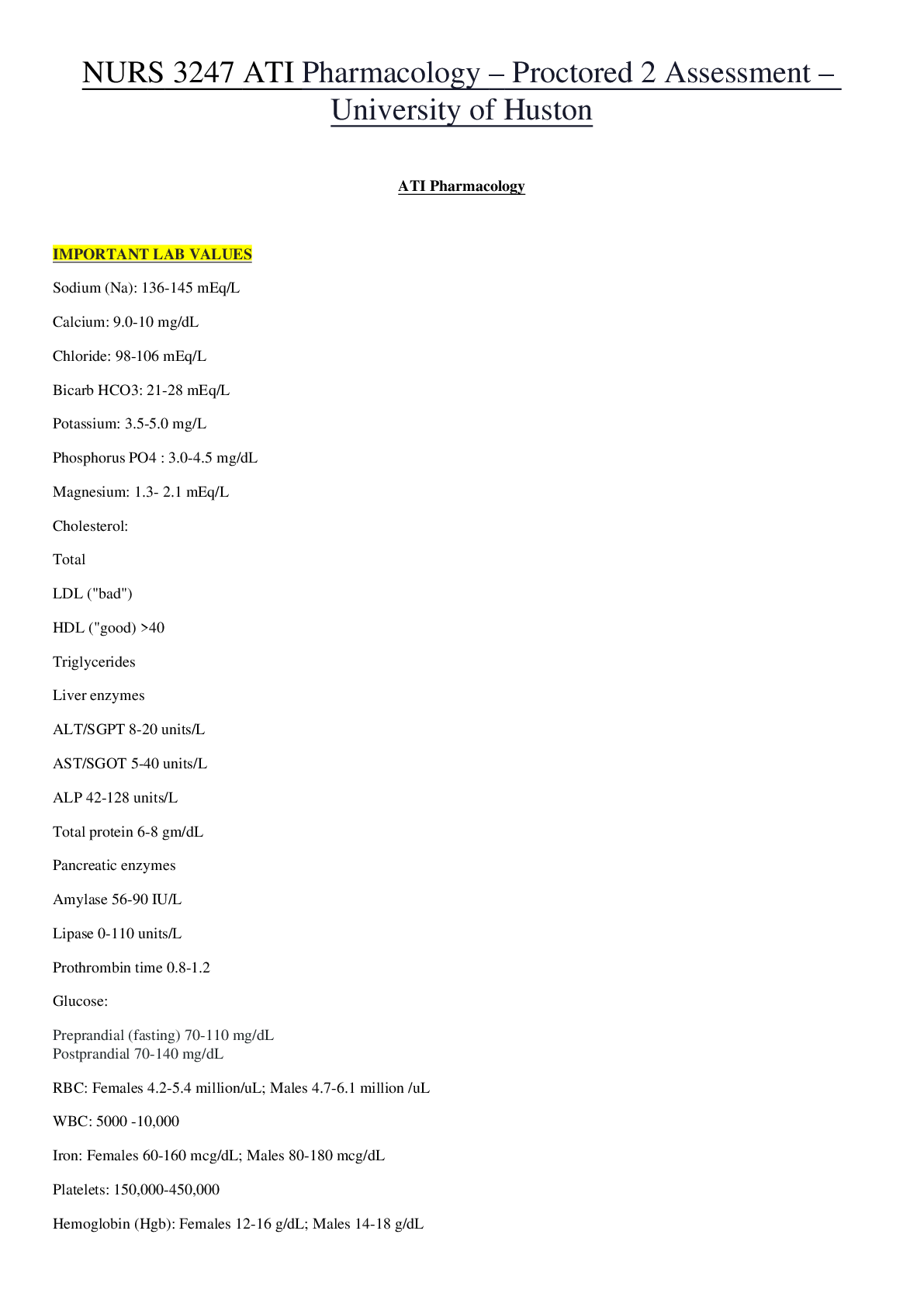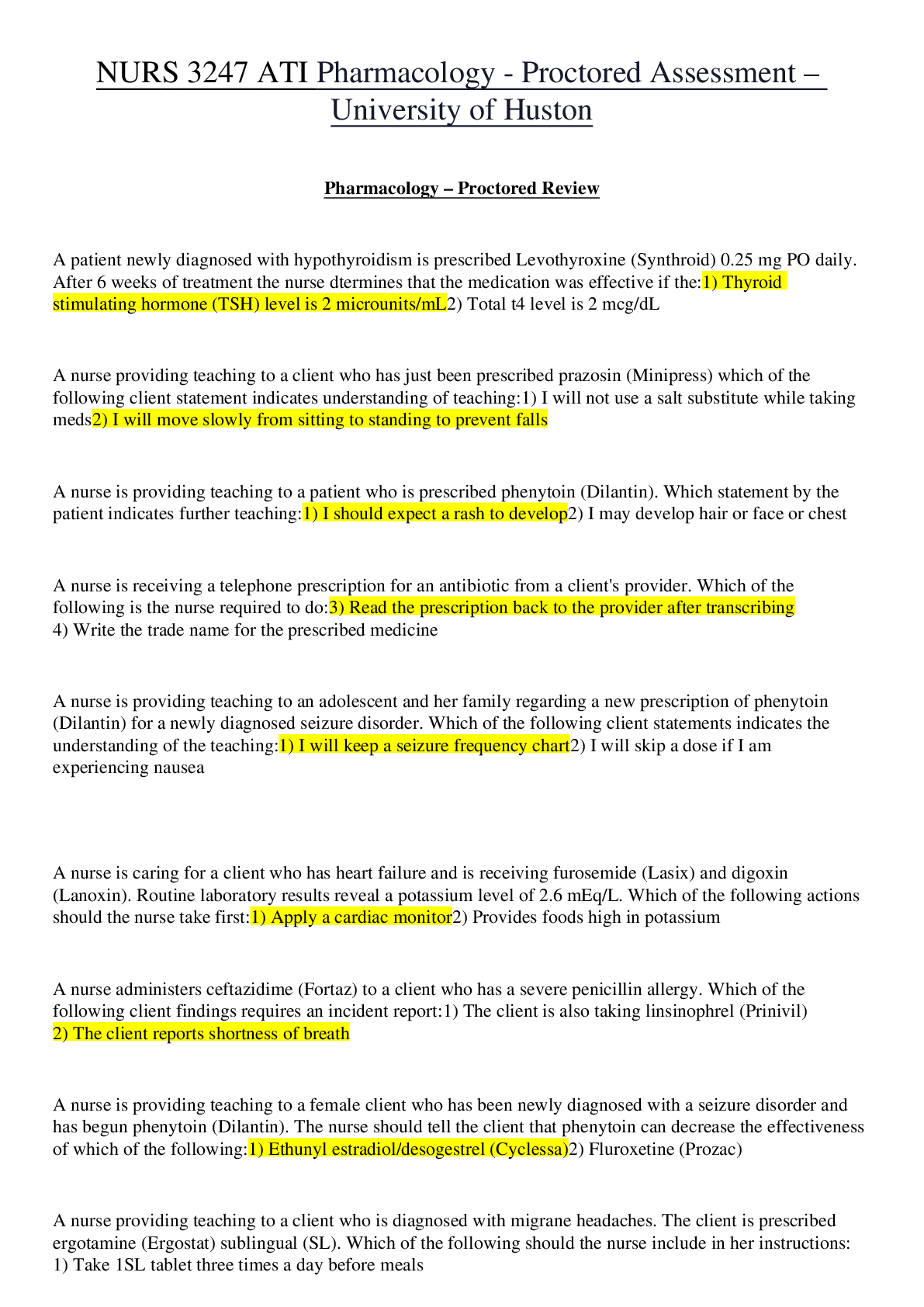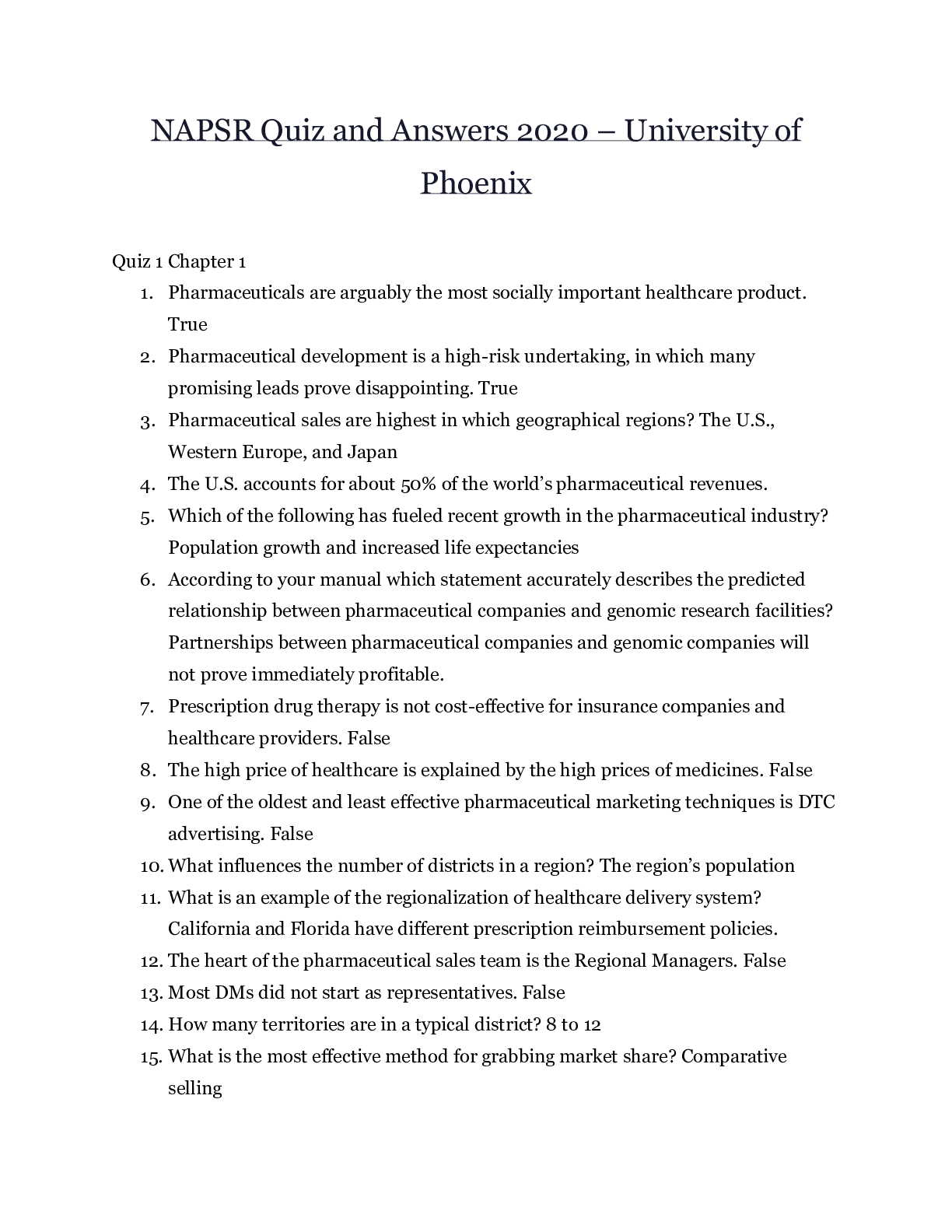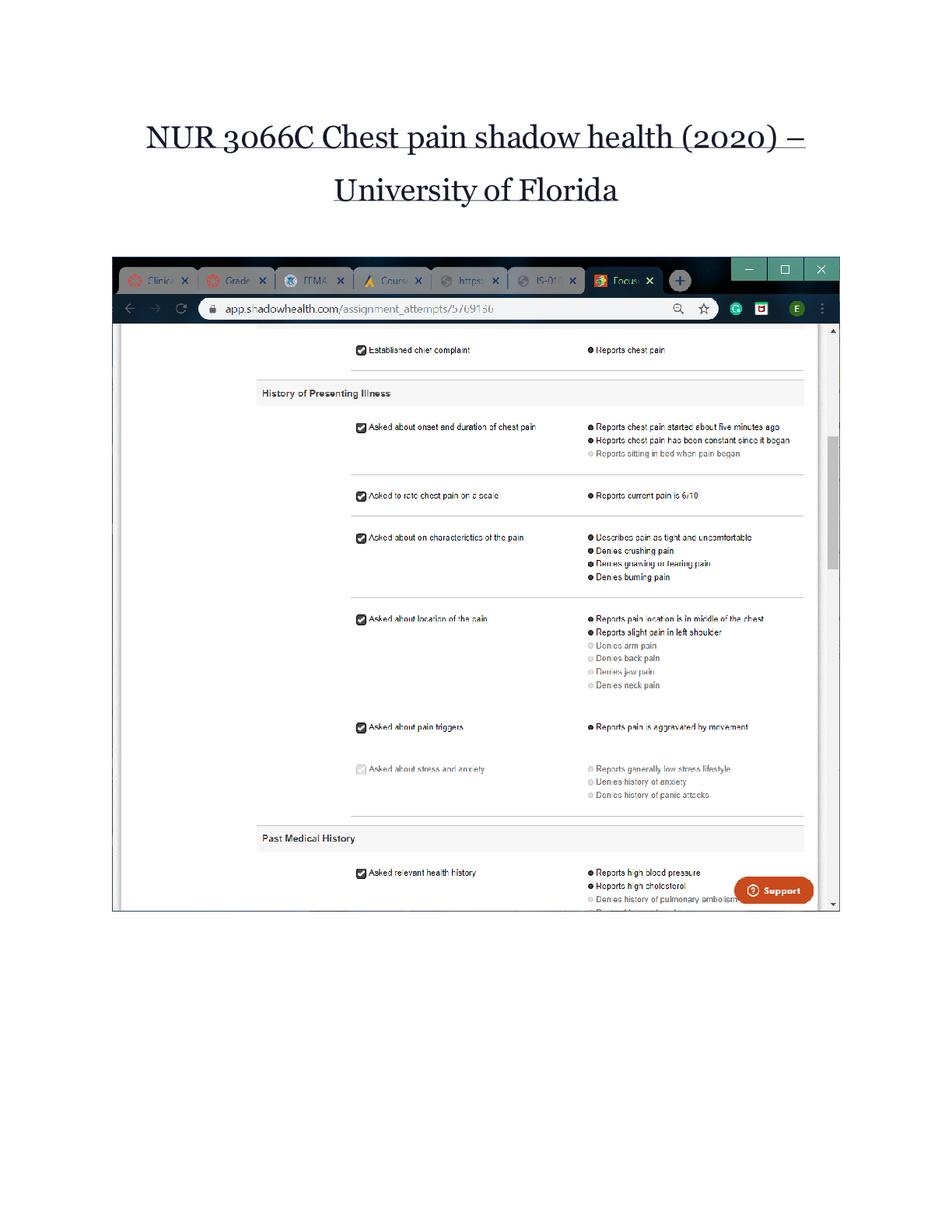NUR 4601 ADULT FINAL BSN EXAM BLUEPRINT latest – University of Texas
Document Content and Description Below
NUR 4601 ADULT FINAL BSN EXAM BLUEPRINT latest – University of Texas ADULT FINAL BSN EXAM BLUEPRINT Hypersensitivity Anaphylaxis-immediate( type 1 hypersensitivity) immunologic reaction betwe... en a specific antigen and an antibody. The reaction results from a rapid release of IgE mediated chemicals, which can induce a severe, life threatening allergic reaction. Nursing Implications - Most patients dismissed after treatment for anaphylaxis did not receive a self-injectable epinephrine prescription or allergist referral. Emergency physicans may be missing an important opportunity to ensure prompt treatment of future anaphylactic reactions and specialized follow up care. Medical Management of Anaphylaxis: ● Initially, respiratory and cardiovascular functions are evaluated. If patient is in cardiac arrest, CPR is performed as well as oxygen provided at high concentrations during CPR or if pt is cyanotic, wheezing, or dyspneic. ● Epinephrine in a 1:1000 dilution is administered sub-q in the upper extremity or thigh and maybe followed with a continuous IV infusion. ● Antihistamines and corticosteriods may also be administered to prevent recurrences of the reaction and to treat urticaria and angioedema ● IV fluids (e.g. normal saline), volume expanders, and vasopressor agents are administered to maintain blood pressure and normal hemodynamic status. ● Patients with episodes of bronchospasm or a hx of bronchial asthma or COPD, aminophylline and corticosteroids may also be used to improve airway patency and function. ● Glucagon IV is utilized if hypotension is unresponsive to vasoppressors ● Patients who experience anaphylaxis and received epinephrine should be transported to the local emergency dept for observation and monitoring because of the risk for a “rebound” reaction 4-10 hours after initial allergic reaction. Nursing Management of Anaphylaxis: ● If patient is having an allergic response, the nurse’s initial action is to assess the patient for symptoms of anaphylaxis such as assessing the airway, breathing pattern, and other vital signs. Also observe patient for signs of increasing edema and respiratory distress. ● Prompt notification of the provider and preparation for initiation of emergency measures (intubation, administration of emergency medications, insertion of IV lines, fluid administration, oxygen administration) are important to reduce the severity of the reaction and to restore cardiovascular function. Allergic Rhinitis( hay fever, seasonal allergic rhinitis) a type 1 hypersensitivity reaction and is the most common form of chronic respiratory allergic disease. Interventions for Allergic Rhinitis: ● Avoidance therapy: ○ The first way to manage allergies is to avoid them. It is the safest and most effective means to treat symptoms associated with allergic rhinitis. That is not always possible. Part of avoiding them is environmental control. ○ Examples are use of air conditioners, air cleaners, humidifiers, and dehumidifiers; keeping windows closed during periods of high pollen counts and windy conditions; removal of dust catching furnishings; removal of pets from the home or bedroom; maintaining a smoke free environment ● Pharmacotherapy ○ Antihistamines (most common medication used) ○ Adrenergic agents ○ Mast cell Stabiliziers ○ Corticosteroids ● Immunotherapy aka allergy vaccine therapy ○ Involves the administration of gradually increasing quantities of specific allergens to the patient until a dose is reached that is effective in reducing disease severity from natural exposure ○ Goals of immunotherapy include reducing the level of circulating IgE, increasing the level of blocking antibody IgE, and reducing mediator cell sensitivity. ○ Immunotherapy has been most effective for ragweed pollen; however treatment for grass, tree pollen, cat dander, and house dust mite allergens ○ Unlike antiallergy medication, immunotherapy has the potential to alter the allergic disease course after 3-5yrs of therapy ○ Because of the risk for anaphylaxis, injections should not be administered by a lay person or by the patient. The patient remains in the office or clinic for at least 30 min after the injection and is observed for possible systemic symptoms. ○ Indications for immunotherapy: ■ Allergic rhinitis, conjunctivitis, or allergic asthma ■ History of a systemic reaction to Hymenoptera and specific IgE antibodies to Hymenoptera venom ■ Desire to avoid the long term use, costs, and potential adverse effects of medications ■ Lack of control of symptoms by avoidance measures or use of medications o Contraindications ● Use of beta blocker or angiotensin-converting inhibitor therapy, which may mask early signs of anaphylaxis ● Presence of significant pulmonary or cardiac disease or organ failure ● Inability of the patient to recognize or report signs of a systemic reaction ● Nonadherence of the patient to other therapeutic regimens and nonlikelihood that patient will adhere to immunization schedule (often weekly for an indefinite period) ● Inability to monitor the patient for at least 30 minutes after administration of immunotherapy ● Absence of equipment or adequate personnel to respond to allergic reaction if one occurs · Contact dermatitis-a type IV delayed hypersensitivity reaction that results from direct skin contact with chemicals or allergens ● Allergic ● Avoidance of offending material ● Burrow’s solution or cool water compress ● Systemic corticosteroids(prednisone) for 7 to 10 days ● Topical corticosteroids for mild cases ● Oral antihistamines to relieve pruritus ● Irritant ○ Identification and removal of source of irritation ○ Application of hydrophilic cream or petrolatum to soothe and protect ● Topical corticosteroids and compresses for weeping lesions ● Antibiotics for infection and oral antihistamines for pruritus ● Phototoxic ● Same as for allergic and irritant dermatitis o Photoallergc ● Same as for allergic and irritant dermatitis · Atopic Dermatitis –a type 1 immediate hypersensitivity disorder characterized by inflammation and hypersensitivity of the skin often causing pruitis ● Treatment includes: ● Decreasing itching and scratching by wearing cotton fabrics ● Washing with a mild detergent ● Humidifying dry heat in winter ● Maintaining room temperature at 20°C to 22°C (68°F to 72°F) ● Using antihistamines such as Benatryl ● Avoiding animals, dust, sprays, and perfumes ● Keep the skin moisturized with daily baths to hydrate the skin ● The use of topical skin emollients is encouraged and remains the main treatment for atopic dermatitis · Food allergy – a IgE mediated food allergy, type 1 hypersensitivity reaction o Therapy for food hypersensitivity includes elimination of the food responsible for the hypersensitivity o The most common severe food allergies are Peanuts and shellfish and tree nut o Other common food allergies are seafood, legumes, seeds, tree nuts, and berries, egg white, buck wheat, milk, and chocolate o Medications therapy includes: H1-blockers, antihistamines, adrenergic agents, corticosteroids, and cromolyn sodium · Dermatitis Medicamentosa(drug reactions) a term applied to skin rashes associated with certain medications. o On discovery of medication allergy, patient are warned that they have a hypersensitivity to a particular medication and are advised not to take it again ○ This is a hypersensitivity type I ○ It’s a drug rash o If this patient going to have this rash, what should you ask them? Answer: What medication are you taking? · Angioneurotic edema and urticaria(hives)-urticaria is a type 1 hypersensitivity allergic reaction ● Benadryl is given to treat the angioedema and urticaria · Serum Sickness – an immune complex type III hypersensitivity o Primary goal in serum sickness therapy is to treat the clinical syndrome symptomatically o Treated with antihistamines and corticosteroids · Latex allergy o Immediate treatment of reaction with epinephrine, fluids, vasopressors, and corticosteroids, and airway and ventilator support, with close monitoring for recurrence for next 12 to 14 hrs o All patients should be asked about latex allergies, although special attention should be given to those with a particular high risk(e.g. patients with spina bifida, patients who have undergone multiple surgical procedures) o Every time an invasive procedure must be proformed the nurse should consider the possibility of a latex allergy o Patient with latex allergy are advised to notify their health care providers and to wear a medical information bracelet o Carry an Epipen at all times and being prepared and able to use it HIV ● one of the test questions is going to be: if you see someone having a vaginal yeast infection constantly. what are you going to think? ○ either have diabetes or they are HIV positive, that tends to be, it depends on the risk factors (they are going to have delayed cutaneous anergy, and i guess it is cutaneous anergy, so what does that mean? concept will be tested upon; anergy skin testing cutaneous, skin testing is delayed) ● acquired immunodeficiency syndrome: consolidation of signs and symptoms (s/s) acquired means the s/s are secondary <secondary diseases> ● opportunistic infections, the opportunistic malignancies that is going to define the depression ● most common cause of acquired immunodeficiency syndrome is HIV ● pneumocystis cardiney pneumonia is the number one opportunistic infection in people who have HIV. (AIDS defining diagnosis) ● new cases of HIV is reported annually (diagnosed): (+) 50,000; i think last yr. was 57,000 (not changed in the last 20yrs) ● #1 risk factor: males having sex with males ● ethnic wise most of the patients are: African American, than white, than hispanics (percentage of the population in the U.S.: black and hispanics is disproportionate) ● 23 cases per 100,000 in Texas: african americans, than hispanic, than white ● predominantly white men in 1981 (men who have sex with men) <steadily dropped> ● african american rate has steadily increased ● number of people living with HIV: 185 per 100,000 in texas, ● the percentage of new HIV infections is reported to current minorities in the United States? ○ 72% (again it’s disproportionate and group that has the highest is still men who have sex with men.) ● HIV is transmitted through: semen/ vaginal secretion/ blood/ breast milk ● don’t get pregnant if you are HIV (+) ○ if you do get pregnant: take your antiretroviral therapy ■ cuts down the transmission rate to less than 0.2% ■ baby is born with the antibodies, but the antibodies as we already now are transient and they will leave the baby’s system within the first year of life ■ don't breast feed ● if you get stuck with a needle at work: report it and take prophylactic antiretroviral therapy ● opt out testing: its imply that every person that goes into the ER because of trauma gets tested unless you tell them no ● public funds are only used for abstinence campaigns on our schools (yet 80% of the H.S. students say they have sex) and is prohibited to provide sterile needles and equipment to drug users ● receptive sex: primary way that HIV is transmitted; men either having sex with men or heterosexual sex (remember the John Irving story she told on how he was always on top; the giver not the receiver of semen) ● one of the highest growing populations, there’s been, in the the last few year is the increasing percentage in older the 65 years old, population risk for contracting HIV (i love giving this as a test question!) ● genetic promiscuity (smart virus): changes its appearance and mutates very rapidly ● two types of HIV: ○ HIV 1 ■ predominantly in europe and united states ○ HIV 2 ■ predominant in west africa (africa has 67% of the world cases) ● primary infection (viremia): ○ cause viremia and then the T lymphocytes will live in the lymph nodes ○ will have a latency period of 8-10 years (where the person has no s/s of HIV) ○ systemic manifestation: ■ fever ■ fatigue ■ lymphadenopathy ■ nausea ■ vomiting ■ pharyngitis ■ diarrhea ■ thrombocytopenia ■ leukopenia ■ if we do testings for antibodies they will be negative ● window of zero conversion: ○ period of time to when they become infected too they develop an antibodies ○ window is from 4-12 weeks ● asymptomatic period: ○ CD4 this count if greater than 500 ○ person remain asymptomatic for many years ● symptomatic period: ○ CD4 count is between 499-200 ○ CD4 gradually declines ○ systemic manifestation: ■ oral/vaginal candida ■ cervical dysplasia (abnormal changes in the cells on the surface of the cervix) ■ untreatable cervical cancer tend to be HIV positive patients ■ human papilloma virus ● herpes zoster ● peripheral neuropathy ● pelvic inflammatory disease (common) ■ immune system is significantly impaired ● invasive cervical cancer ○ pap smears every 6 months ○ usually treated with a hysterectomy ● candida of the lungs ● Karposi’s sarcoma ● Non-Hodgkins lymphoma ○ treated with chemotherapy radiation ● pneumocystis carinii ○ get prolaxis when their CD4 drops below 100 ○ vaccines (Hep. A/B, pneumococcal, and influenza) ○ ineffective airway clearance ● TB ● wasting syndrome ○ nutrition is a really big thing ○ small frequent meals ○ favorite foods ○ high calorie snacks ○ diarrhea is a problem (peritoneal care is a big thing) ○ imodium ● dementia ● HIV antibody test: ○ Elisa ■ identify 1 antibody ■ rapid testing (oraquick rapid mouth swab) ■ 2 weeks for results ■ remember her story about one of her students doing testing outside nightclubs ○ western Blot ■ identify 2 different antibodies ■ confirmation of HIV ● monitor normal CD4 T cells: 500 to 1,600 ○ count drops they are going to have increased in opportunistic infections ○ get a viral load (a viral culture is rarely done, it takes to long) ■ indicates the level of the virus in the blood ■ used to monitor the disease, the progression, and treatment (anti-retroviral treatment; with treatment the viral load becomes undetectable) ■ higher the viral load = more infectious they are ■ genotype: going to identify the mutation ■ phenotype: identify resistance ● going to get a CBC every 6 months, chemistry panel (liver, renal, and their nutrition), annual PPD (HIV reaction of 5 mms are going to be treated), chest x-ray, pregnancy tab, pap smears every 6 months, and STD testing ● HIV patients are co-infected with Hep. B and C ● medications ○ if a lapse in medication administration it will cause the virus to mutate (smart virus!!!), so its important to give the medication as prescribed ○ non-nucleoside reverse transcriptase inhibitors ■ cause CNS problems, trouble concentrating and changing/vivid dreams ○ nucleosides reverse transcriptase inhibitors ■ cause lip dystrophy (big problem!!!), lose fat in their face and their face becomes very hollow ○ protease inhibitors ■ adverse effect is metabolic syndrome, lipo-dystrophy, or have abdominal obesity ○ fusion inhibitors ■ given IV, are reserved for people who are resistant (have a strain that is resistant) to the oral medications ■ now called anti-retroviral therapy ● CMV is the most common cause of retinitis (causes them to go blind) ● get prophylactic treatment at 200 ● remember first manifestation of HIV is viremia (virus enters the bloodstream and have access to the rest of the body) <after that you may not have s/s after 8-10 years> ● HIV: CD4 decreases and Viral load increases Hematology Anemia: Anemia is a condition in which the hemoglobin concentration is lower than normal and reflects the presence of fewer than normal erythrocytes (RBCs). As a result, the amount of oxygen delivered to tissues is also decreased. Anemia is the most common hematologic condition and it most prevalent among the elderly with rates in nursing homes as high as 48%. The more rapidly anemia develops, the more severe its symptoms. The most common symptom and complication is fatigue. Inadequate intake of essential nutrients such as iron, vitamin B12, and folic acid can cause some anemias. A - - - - - - - - - - ● There will be a lot of Teaching ● When dealing with treatment, treat them with Tender, Love and Care (TLC) Because Breast Cancer is systemic, very often Chemo is part of it. ● Treatment can be a single approach or adjuvant. Involving chemo followed by radiation or radiation followed by chemo. ● It can be either Chemo or it can be Hormonal Treatment or it can be Biological Immunologic Treatment, which in fact is trying to help out the immune system. ● A lot of the immune system have these cancer cells go undetected ● If the immune system would have real robust they would attack it (They would say, “Hey the immune system has an unusual cell lets gobble it up”), but instead it goes undetected. Chemo Tx Most Chemotherapy Agents have major side effects: Common Agents include: ● Cyclophosphamide (Cytoxan) ● Doxorubicin (Adrianmycin) ● Methotrexate (Mexate) ● 5-Fluorouracin (5-FU) ● Paclitaxel (Taxol) ● Docetaxel (Taxotere) ● Leucovorin (Wellcovorin) Chemo Side Effects ● Dealing with the Women: They feel fatigue, nausea, vomiting, diarrhea, bloating and stomatitis ○ Stomatitis is irritation of the mouth. With chemotherapy, no matter what cancer it is they are going to have stomatitis. It can be treated with baking soda rinse or ice cubes. ● Hair thinning can also be seen in those who use Cytoxan, Mexate & 5-FU even though they don’t go bald. ● With some chemo agents such as Adriamycin & Cytoxan some of the people may lose some of their hair. ● Weight Gain can also occur ● They can get Cystitis (Infection of the Urinary Tract) and have Neurotoxicity numbness to the fingers and toes ○ Inability to have the fine motor activities ● They also get Constipated ● People in Chemotherapy are usually very thin and skinny because they have anorexia. ○ But for some people the medications promote bloating of the stomach appearing like a rounded abdomen. Kadcyla (Medication) is a new FDA-approved “cocktail” for aggressive, advanced, metastatic tumors that over produce HER-2 Proteins. ● This is a new therapy offering promise. ● It’s a combination of Herceptin (Trastuzumab) and the Chemotherapy Drug DMI ● In advanced cancers its very helpful, as it extends the life not by a whole lot but by about 6 months but it gives a better quality of life ● Now they are thinking of trying this chemo combination on people with early cancer to see if it’s going to have a different outcome Radiation can be alone or in combination ● External Beam (ERT) is an outpatient basis where the person lays down: Goes 5 day/ Week for 4-7 Weeks ● Internal (IRT) is where they will implant the radiation either during surgery or either with applicators and they are only for a short time of period. (5-7days) Radiation Side Effects ● With any radiation there are going to be skin changes. ● There is also emotional and physical and perhaps spiritual fatigue ● Arm Edema- Because of the inflammatory process that’s happening. Remember the lymph nodes are involved and they will probably be involved in the radiation so there’s going to be edema. ● Dry Throat- Even though they’re directing it to the breast and not the throat, therey’s going to be some scatter that happens. ● May also affect the ribs and cause Rib Fractures ● It can affect the Lungs. Right underneath the chest so they may have Pneumonitis (Inflamed Lungs) (Dry Cough and Throat & Dyspnea) Breast Cancer Surgery ● Lumpectomy it’s a partial mastectomy ○ Is where you go in and take out the piece of the tumor surrounded by clean margins. They don’t want to leave any tissue there that has the cancer in it. In many of these surgeries you really can’t tell, as the breast kind of redistributes itself after the surgery. ● Mastectomy it can be either modified or radical ○ Radical is when they take everything out. They take out the muscle, the lymph nodes, the skin, the nipple, they take everything. ● Sometimes they do Axillary Dissection ○ This means taking out certain lymph nodes ● There is also a Sentinel Node Biopsy ○ Sentinel means guard and so the lymph nodes are like the first line of the battle field. ○ What they do in this biopsy is: They inject a dye and they watch to see which of those lymph nodes get the dye first,then they take out those notes and they send them to pathology ○ If those lymph nodes have cancer in them then they usually go in and take out many more nodes. ○ If those nodes do not have the abnormal cells in them they they say everything is okay and they leave it at that. ● As you can imagine the more lymph nodes you can leave the better the quality of life is going to be for the woman because the lymph nodes are filtering all the time. ○ If they have to take out all the lymph nodes then the arm is going to end up being more swollen all the time. ■ You can’t do IV or injections or probably even blood pressures. They have to use electric shavers to shave under the arm because they don't have the lymph nodes to protect them. Some people don’t even want you to have deodorants because they don’t want you to have a reaction to the deodorant. ● The decreased strength in that arm, they have to go through gentle range of motion. ● And then there is Reconstructive Surgery. Breast Cancer Postoperative ● The women will grieve, even the women that had a lumpectomy will grieve. They will grieve because they have lost their sense of security because now she has been diagnosed with cancer, and they will grieve depending on how much of her breast has been lost. Her lifestyle has been lost as well. ● Psychosociocultural again how important was this breast to her identity? From her husbands perspective, his view of her. ● Physical, body image/cosmetic- What kinds of things are we going to do to enhance that persons body image? Sometimes is very helpful to get people that have already been diagnosed with cancer, specially the same type of cancer, to come and visit them. ● American Cancer Society, has a program for all kind of different cancer survivors and sometimes if they are contacted they can arrange for visitors. I think they have to have doctors order from a physician but they can arrange people to come and talk to them and say “These are the kinds of things you can do initially. This is what you can do later.” ● They have programs for exercise that tell you about how to exercise appropriately. ● If you have something from someone that has already gone through it and is saying “Yes you can do it, I did it and you can do it too” its much more meaningful. ○ They talk about where to get prosthetic for bras or about makeup. They can tell you about how to deal with this or other things, so it’s very helpful. ○ They can also tell you about the wigs, and how to tie scarves. ○ In MD Anderson they have these areas where all the people with all of their various surgeries and disfiguration. They go and they can help them how to dress, how to fix their hair, how to tie their scarves. It can be a positive experience. ● The Rehab that can in fact include the arm exercises and things like that. Breast Cancer Postoperative ● Right after surgery there will be the need to care for the surgical sites. ● Often times because of the breast, I guess because it has so much fatty tissue, when they have a removal of the breast they will need drains. ● Keeping it drained will facilitate healing ● If the fluid stays in place and doesn't drain it can contribute to discomfort and infection. ● There can be hematomas underneath the breast wound. There can be seromas which is just a collection of serous fluid. And also certainly there can be pain and infection. ● Initially try to get them more involved in as much self-care as possible. Get them to do little things, like doing their own hair or feeding themselves. Get them to feel that they have some control over their lives. Breast Postop Care ● If the lymph nodes were involved or not their arm is still going to be inflamed because they did surgery on that breast. ● Make sure it’s the ipsilateral arm. ● Look to make sure there is no erythema or edema. ● Touch to see if there is warmth ● Ask if there is pain ● You need to position and support the arm. It needs to be drained so have the arm slightly elevated. Have enough pillows so that you can slightly elevate the arm to help in the drainage. Early Exercises On Day 1 ● You can just have them opening and closing the hand and the fingers. ● You can give them those squeezing balls for stress ● Flexion and extension of elbow ● Deep breathing; In and Out Exercises on Day 2 ● Shoulder shrug and Flexion ● You aren’t going to have them do external rotation because it will pull on the wound and the arm is not ready for that. Reach to Recovery ● This program is associated with American Cancer Society: The early exercises are very important. Slowly but surely you advance: “Their fingers walked up the wall” which means Reaching to Recovery. ● Anytime you have a client with cancer, you should check the American Cancer Society and see what kind of information they have. Breast Cancer Postop ● Post-operatively you have to understand that the more positive you are the better. ● You should do that in terms of any care plan that you are doing and not just come up with deficit, alterations or deviation but think in terms of what can be positive. ● Yes the women had a lumpectomy but maybe she is saying, “I am aware of that and i am coping and grieving effectively.” So Effective Grief/Coping can be a positive nursing diagnosis. ● “I am ready to learn. Teach Me” Readiness to Learn is another nursing diagnosis, you are not going to say Knowledge Deficit. ● Adapting to New Body Image, Appropriate Body Grieving, and Effective Coping are another nursing diagnosis. ● Risk for Impaired Skin Integrity: This was on a client who had postoperatively mastectomy. She went to surgery and of course she will be on risk for impaired skin integrity. Don’t put this on a postop care plan. Client Goals ● Anytime you have a client goal it’s one verb per goal. Each verb equals a goal. ● If you have more than one verb, put them into three different goals-Make sure they are measurable verbs. [Show More]
Last updated: 2 years ago
Preview 1 out of 156 pages

Buy this document to get the full access instantly
Instant Download Access after purchase
Buy NowInstant download
We Accept:

Reviews( 0 )
$22.00
Can't find what you want? Try our AI powered Search
Document information
Connected school, study & course
About the document
Uploaded On
May 20, 2020
Number of pages
156
Written in
Additional information
This document has been written for:
Uploaded
May 20, 2020
Downloads
0
Views
125








 – University of the People.png)
